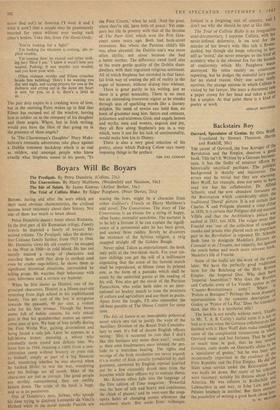Boyars Will Be Boyars
The Prodigals. By Petru Dumitriu. (Collins, 25s.) The Trial of Callista Blake. By Edgar Pangborn. (Peter Davies, 21s.) BEFORE, during and after the wars which are their most obvious characteristics, the civilised nations boast raucously about their history. Not one of them has much to boast about.
Petru Dumitriu doesn't boast about Rumania. In the first part of his Rumanian trilogy, Family Jewels, he depicted a family of boyars. His second volume, The Prodigals, takes the destruc- tive Coziano family further, from 1915 to 1944. Mr. Dumitriu views his old country—he escaped to the West in 1960—in cold blood. He has not merely massed a troop of characters and marched them until they drop (a method used even by cruder saga-tellers), he shows them in significant historical situations, surrounded by telling props. He watches their behaviour with care, bitterness and a certain icy humour.
When he first shows us Dimitri, one of the principal characters, Dimitri is a fifteen-year-old returning from high school to his sophisticated family. Ten per cent of the boy is arrogance towards the peasants, 90 per cent. a violent ache for his first woman. Though the house seems full of nubile cousins, his only sexual gain is that his grandmother makes an unwel- come pass at him. We hear of him briefly during the First World War, gaining decorations and being found a safe job. Later he appears as a full-blown lecher, pursuing a whore who eventually turns round and defeats him. We leave him in 1944, rescuing a rabbi from a con- centration camp without bravery or even risk to himself, simply as part of a big financial deal, wondering whether he was shrewd when he backed Hitler to win the war, wondering why his feelings are all numb. Most of the characters are just as corrupt. The good people are terribly outnumbered, they are swiftly beaten down. The scope of the book is huge, and so is its pessimism.
One of Dumitriu's men, Serban, who spends his time trying to discover Leonardo da Vinci's Method while in the street outside Fascists are tearing the Jews, might be a character from either Gulliver's Travels or Harry Matthews's odd novel, The Conversions. The story of The Conversions is an excuse for a string of happy, often funny, surrealist anecdotes. The narrator is to be left a fortune if he can explain the signifi- cance of a ceremonial adze he has been given, and answer three riddles. Slowly he discovers the existence of the Sylvian religion, a twig snapped straight off the Golden Bough.
Never mind. Taken as entertainment, the book only palls at the two-thirds mark. For your six- teen shillings you get the will of a millionaire stipulating that the score of his funeral march shall be reproduced, at fifteen times its printed size, in the form of a pancake which shall be eaten by the uninvited guests at the reading of his will. You also get the revolt of the Parisian Panarchists, who enlist both sides in an inter- national ice hockey match to truss the ministers of culture and agriculture and use them as pucks. Apart from the laughs, I'll also remember the off-beat parable of The Otiose Creator for some time.
The Isle of Saints is an inescapably polemical novel which sets out to justify the ways of the Auxiliary Division of the Royal Irish Constabu- lary to man. It's full of decent English officers saying : 'Has it occurred to you that I don't like this business any more than you?,' exactly as their own headmasters once intoned the pre- lude to a merciless beating. The rights and wrongs of the Irish revolution are never argued, it's a matter of Irish atrocity (conducted by daft gunmen), answered by English reprisal (carried out by a few excusably drunk men from the trenches while their officers try to restrain them).
Mr. Kinross often falls into the language of the Eke edition of Time magazine: 'Powerful was the hum of talk and heavy and continuous the chink of glasses,' and he over-uses the soap- opera habit of changing scenes whenever the excitement starts. But aside from technique, Ireland is a forgiving sort of country, and I don't see why she should be spat at like this.
The Trial of Callista Blake is an imaginative semi-documentary, I suppose. Callista, with her never-defined deformity, is on trial for the murder of her lover's wife. Her talk is flower- decked, but though she keeps referring to her- self as 'weird,' she never emerges as the kind of eccentric who is the obvious fox for the hounds of conformity which Mr. Pangborn wants
destroyed. He relies mainly on courtroomreporting, but he dodges the essential jury scene for no stated reason. Only one scene really survives, the strange episode in which Callista is visited by her lawyer. She tears a document into a paper crown for her head and takes a ruler for a sceptre. At that point there is a kind of poetry at work.
ADRIAN MITCHELL


































 Previous page
Previous page